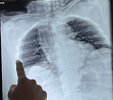“The existing evidence does not indicate that operative man- agement produces superior outcomes. The significant complication rate associated with operative treatment (as high as 70%) may explain the overall lack of superiority with regards to outcome measures.
Large studies have attempted to settle such controversy with little success. The most high profile of these studies is the PROFHER trial.19 In this pragmatic, multicenter, parallel-group, randomised clinical trial 250 patients (aged 24e92) were randomised between surgical and non-surgical intervention. The trial demonstrated that there were no significant differences in Oxford shoulder scores at 2 years between the groups. A follow up study was carried out on 149 of these patients at 5 years.4 It confirmed the original findings of the PROFHER trial. Other studies, such as the meta-analysis on 3 and 4-part fractures by Li et al. (2013),40 also found that the fixation of these fractures was not superior to conservative management.
The question for orthopaedic surgeons is therefore whether or not surgical fixation has any role in the management of these fractures. Scrutiny is therefore required of the above studies. Although the PROFHER trial has various strengths it is also a fundamentally flawed trial with several weaknesses. The hetero- genicity of the selected patients in terms of age and fracture pattern alone may have clouded the conclusions drawn by the authors. The fact that the trial was carried out across 30 different centres and by 66 different surgeons raises questions about the consistency of the treatment. Perhaps the most significant factor is the exclusion of patients “with a clear indication for surgery”. Finally, the inclusion of all surgically treated patients into one category would appear to be erroneous as it has been shown that patients with different forms of surgical treatment have different outcomes.41e44
A Cochrane review by Handoll and Brorson18 suggested that “there is high or moderate quality evidence that, compared with non-surgical treatment, surgery does not result in a better out- comes at one and two years after injury for people with displaced proximal humeral fractures involving the humeral neck”. It is important to note however, that the evidence did not cover the treatment of two-part tuberosity fractures, fractures in young people, high energy trauma, or less common fractures such as fracture dislocations and head splitting fractures.
In conclusion, it is clear that the majority of minimally displaced and simple proximal humeral fractures can be safely managed non- operatively. What is also clear is that large, well designed trials are needed comparing non-operative management with specific operative techniques in specific patient groups with 3 or 4-part fractures, before significant conclusions can be drawn with regards to management of these fractures. One such trial is un- derway comparing 3 and 4-part fractures in the proximal Humerus, specifically in elderly patients.45 The authors also keenly await the release of the findings of the PROFHER 2 trial.”


